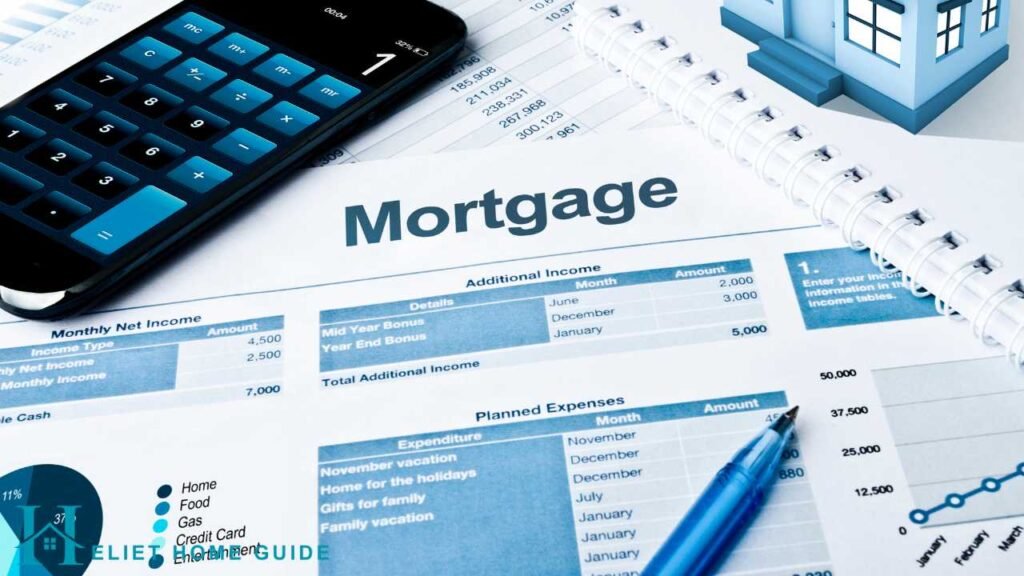Most home buyers are not wealthy enough to pay the entire purchase price of a home up front, so they make a down payment, usually a percentage of the total purchase price, and take a mortgage loan to cover the rest. A lender, often a bank, agrees to lend the amount needed after subtracting the down payment from the full purchase price. For example, if a home costs $200,000 and the buyer pays 20% ($40,000), the principal will be $160,000.
- Repayment happens through monthly mortgage payments, which include interest and reduce the principal. If a buyer fails to pay, the lender can foreclose and take the house back.
- First-time buyers can qualify for FHA (Federal Housing Administration) programs that require a down payment as low as 1–3%, but this adds additional costs. It’s always best to talk to a lender about what you might qualify for.
| Home Price | Down Payment (20%) | Mortgage Loan Amount |
| $200,000 | $40,000 | $160,000 |
“Homeownership is a cornerstone of wealth, providing both financial stability and emotional comfort.” – Suze Orman
The Role of Taxes and Insurance in Your Mortgage
When calculating PITI, your total monthly mortgage payment includes principal, interest, taxes, and insurance. Many lenders require borrowers to pay property taxes as part of their monthly payments, often a prorated portion of the annual property taxes, such as $2,400, which could mean $200 added each month. Homeowners insurance is also necessary, as it covers the home and its contents from fire, flood, or damage. If a home buyer cannot make a 20% down payment, they may need private mortgage insurance (PMI) to protect the lender if they default on the mortgage, adding $50–100 to their monthly mortgage bill.

| Annual Property Tax | Monthly Tax Payment |
| $2,400 | $200 |
Exploring Different Mortgage Options
When choosing a mortgage, it’s important to understand the two main types commonly offered by lenders. A fixed-rate mortgage maintains a constant interest rate throughout the loan term, ensuring consistent monthly payments. On the other hand, an adjustable-rate mortgage starts with a lower interest rate that can change over time, which might save money initially but comes with the risk of higher payments later.

| Mortgage Type | Interest Rate | Monthly Payment Stability |
| Fixed-Rate | Stays the same | Predictable payments |
| ARM (Adjustable-Rate Mortgage) | Changes over time | Varies based on market |
“A house is made of bricks and beams. A home is made of hopes and dreams.” – Unknown
Fixed-Rate Mortgages: Stability in Payments
When you take on a mortgage, it’s important to think about how interest rates can rise and fall over time. For example, in the early 1980s, rates rose almost 19%, while in 2006, they were about 5%. A fixed-rate mortgage helps by locking you into a permanent rate, which protects you from market fluctuations. This means your payments stay the same, no matter how the economy changes.

Predictable Expenses with Fixed-Rate Loans
A fixed-rate mortgage offers stability because the interest rate never changes, no matter how economic shifts cause rates to spike. This means your monthly mortgage payments never change, so if you are paying $1,500 a month today, you will still be paying the same amount a decade later.

Higher Initial Costs of Fixed-Rate Loans
One downside of a fixed-rate mortgage is its higher initial costs, as interest rates tend to be greater than those of adjustable-rate mortgages, leading to monthly payments that are expensive, especially in the first 3–10 years. These mortgages usually last 15, 20, 30, or 40 years, but the most common choices are 15- and 30-year loans.

Adjustable-Rate Mortgages: Flexibility in Interest Rates
An adjustable-rate mortgage (ARM) offers a mix of stability and flexibility, as its interest rate can change at certain points during the term of the loan. Unlike a fixed rate loan, ARMs provide an initial period of time—typically 3 years, 5 years, 7 years, or 10 years—where the rate remains constant before it adjusts to align with financial markets. The adjustment ensures that the rate matches what lenders are offering at that time, which can either lower or raise monthly payments depending on market trends.

| Initial Fixed Period | Typical Terms |
| 3–10 years | 15–30 years |
“Do not wait to buy real estate. Buy real estate and wait.” – Will Rogers
Benefits of Adjustable-Rate Mortgages
One big benefit of an ARM is its lower initial costs, making it easier for buyers to afford a home. During the initial fixed term, the interest rates are lower than those of fixed-rate mortgages, leading to lower monthly payments. However, once this fixed-term phase ends, the rates may increase to match permanent rates, so planning ahead is essential.
Potential Risks of ARMs
A big risk of choosing an ARM is that while the initial rates start lower than a fixed-rate mortgage, they may increase once the fixed term ends, causing higher payments if rates rise. Different ARMs handle interest rate adjustments in various ways—some adjust once and act like a fixed-rate mortgage, while others continue adjusting every 6–12 months to match current rates. Typically, ARMs come with 15- or 30-year terms, similar to fixed-rate mortgages.
Interest-Only Mortgages: Lower Initial Payments
- Certain types of ARMs give borrowers the option to pay only interest-only on their loan for a fixed period of time, typically 5 years or 7 years.
- This keeps monthly payments lower than those of standard fixed-rate mortgages or other ARMs since the principal isn’t paid down during the interest-only period.
- Once this period expires, borrowers must either pay the balance in a lump sum, which can be tens or hundreds of thousands of dollars, or start paying off the principal through each monthly payment.
- This can cause payments to rise dramatically, especially if interest rates rise, which could make them skyrocket—even if rates don’t rise, the shift to principal payments alone can significantly increase costs.
Mortgage Tax Advantages
The U.S. government actively encourages its citizens to buy homes by allowing them to deduct their mortgage interest from taxable income. This deduction helps lower the monthly mortgage payment based on the income tax bracket. For example, if someone falls into the 28% tax bracket and has a monthly mortgage payment of $1,000, only 72% of the interest needs to be paid after deductions, reducing it to $720. These tax deductions are especially beneficial in the early years of a mortgage, as payments are structured so that in the first few years, homeowners pay much more interest than principal. As a result, during the first months and years, nearly the entire monthly payment remains tax deductible.
| Tax Bracket | Mortgage Payment | After Deduction |
| 28% | $1,000 | $720 |
“Real estate is a secure asset—it cannot be stolen, lost, or taken away.” – Franklin D. Roosevelt
Understanding Loan-to-Value (LTV) Ratio
- You mentioned down payments, but didn’t cover LTV directly. LTV is a key factor in determining mortgage rates, PMI requirements, and approval chances. Including a section explaining LTV would be beneficial.
| Home Price | Loan Amount | LTV Ratio |
| $250,000 | $200,000 | 80% |
How Debt-to-Income (DTI) Affects Loan Approval
- Many lenders use DTI to assess loan eligibility. A section on how to calculate and improve DTI would help buyers understand their borrowing capacity.
| Monthly Debt | Monthly Income | DTI Ratio |
| $2,000 | $5,000 | 40% |
Government-Supported Loan Options
- FHA loans are mentioned, but VA (for veterans) and USDA (for rural homebuyers) loans are missing. These are great options for people who might not qualify for conventional loans.
Biweekly vs. Monthly Mortgage Payments
- A short explanation of how switching to biweekly payments can reduce mortgage duration and save on interest would be useful.
| Payment Type | Annual Payments | Impact |
| Monthly | $12 | Standard |
| Biweekly | 26 | Pays off loan faster |
Frequently Asked Questions
What is a mortgage?
A mortgage is a loan used to buy a home. The borrower makes monthly payments covering principal and interest, and the lender can repossess the home if payments aren’t made.
What is the difference between a fixed-rate and an adjustable-rate mortgage?
A fixed-rate mortgage has a constant interest rate, ensuring predictable payments. An adjustable-rate mortgage starts with a lower rate but fluctuates over time, potentially increasing costs.
What is PMI, and when is it required?
Private Mortgage Insurance (PMI) protects lenders when borrowers pay less than 20% down. It’s an extra monthly cost added to mortgage payments until sufficient home equity is built.
What is Loan-to-Value (LTV) ratio?
LTV measures the mortgage amount compared to the home’s value. A lower LTV means better loan terms, while higher LTV may require PMI or higher interest rates.
How does debt-to-income (DTI) ratio impact mortgage approval?
DTI compares monthly debt payments to income. Lenders prefer a DTI below 43%, as a lower ratio indicates better financial stability and a higher likelihood of mortgage approval.
What are government-backed mortgage loans?
FHA, VA, and USDA loans are government-backed options. FHA loans require low down payments, VA loans assist veterans, and USDA loans support rural homebuyers with flexible terms.
How can biweekly payments reduce mortgage costs?
Biweekly payments split monthly payments into two smaller ones, leading to 26 payments annually instead of 12. This method shortens loan terms and reduces interest payments.
What are mortgage tax benefits?
Homeowners can deduct mortgage interest from taxable income, reducing tax liability. This benefit is most useful in the early loan years when interest payments are highest.
How does an interest-only mortgage work?
Interest-only mortgages allow borrowers to pay only interest for an initial period. Afterward, payments increase significantly as principal repayment begins, making future costs higher.
What happens if I miss a mortgage payment?
Missing a payment may result in late fees and credit score damage. If payments continue to be missed, foreclosure could occur, leading to loss of homeownership.
Conclusion
A mortgage is one of the most significant financial commitments a person can make, and understanding its various aspects—such as loan types, interest rates, taxes, insurance, and repayment options—is crucial for making informed decisions. Whether choosing a fixed-rate mortgage for stability or an adjustable-rate mortgage for initial savings, buyers must consider their long-term financial goals. Government-backed loans and tax benefits can further ease the burden of homeownership, while factors like Loan-to-Value (LTV) and Debt-to-Income (DTI) ratios influence mortgage approval. By carefully evaluating mortgage options and payment strategies, homebuyers can secure a loan that best suits their needs and ensures long-term financial security.

Rhys Henry is a Luxury Realtor & Senior Partner at Tyron Ash International, specializing in South East London & Kent Division. A dedicated real estate agent, Rhys is passionate about helping clients navigate buying, selling, and investing in luxury properties with expert guidance and industry-leading strategies.

